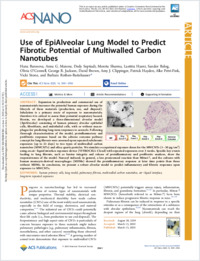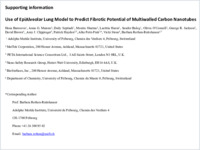Use of EpiAlveolar lung model to predict fibrotic potential of multiwalled carbon nanotubes
- Barosova, Hana Adolphe Merkle Institute, University of Fribourg, Chemin des Verdiers 4, 1700 Fribourg, Switzerland
- Maione, Anna G. Mat, Tek Corporation, 200 Homer Avenue, Ashland, Massachusetts 01721, United States
- Septiadi, Dedy Adolphe Merkle Institute, University of Fribourg, Chemin des Verdiers 4, 1700 Fribourg, Switzerland
- Sharma, Monita PETA International Science Consortium Ltd., 8 All Saints Street, London N1 9RL, U.K.
- Haeni, Laetitia Adolphe Merkle Institute, University of Fribourg, Chemin des Verdiers 4, 1700 Fribourg, Switzerland
- Balog, Sandor Adolphe Merkle Institute, University of Fribourg, Chemin des Verdiers 4, 1700 Fribourg, Switzerland
- O’Connell, Olivia Mat, Tek Corporation, 200 Homer Avenue, Ashland, Massachusetts 01721, United States
- Jackson, George R. Mat, Tek Corporation, 200 Homer Avenue, Ashland, Massachusetts 01721, United States
- Brown, David Nano-Safety Research Group, Heriot-Watt University, Edinburgh EH14 4AS, U.K.
- Clippinger, Amy J. PETA International Science Consortium Ltd., 8 All Saints Street, London N1 9RL, U.K.
- Hayden, Patrick Mat, Tek Corporation, 200 Homer Avenue, Ashland, Massachusetts 01721, United States - Bio, Surfaces, Inc., 200 Homer Ave, Ashland, Massachusetts 01721, United States
- Petri-Fink, Alke Adolphe Merkle Institute, University of Fribourg, Chemin des Verdiers 4, 1700 Fribourg, Switzerland - Department of Chemistry, University of Fribourg, Chemin du Musée 9, 1700 Fribourg, Switzerland
- Stone, Vicki Nano-Safety Research Group, Heriot-Watt University, Edinburgh EH14 4AS, U.K.
- Rothen-Rutishauser, Barbara Adolphe Merkle Institute, University of Fribourg, Chemin des Verdiers 4, 1700 Fribourg, Switzerland
-
28.04.2020
Published in:
- ACS Nano. - 2020, vol. 14, no. 4, p. 3941–3956
English
Expansion in production and commercial use of nanomaterials increases the potential human exposure during the lifecycle of these materials (production, use, and disposal). Inhalation is a primary route of exposure to nanomaterials; therefore it is critical to assess their potential respiratory hazard. Herein, we developed a three-dimensional alveolar model (EpiAlveolar) consisting of human primary alveolar epithelial cells, fibroblasts, and endothelial cells, with or without macrophages for predicting long-term responses to aerosols. Following thorough characterization of the model, proinflammatory and profibrotic responses based on the adverse outcome pathway concept for lung fibrosis were assessed upon repeated subchronic exposures (up to 21 days) to two types of multiwalled carbon nanotubes (MWCNTs) and silica quartz particles. We simulate occupational exposure doses for the MWCNTs (1–30 μg/cm2) using an air–liquid interface exposure device (VITROCELL Cloud) with repeated exposures over 3 weeks. Specific key events leading to lung fibrosis, such as barrier integrity and release of proinflammatory and profibrotic markers, show the responsiveness of the model. Nanocyl induced, in general, a less pronounced reaction than Mitsui-7, and the cultures with human monocyte- derived macrophages (MDMs) showed the proinflammatory response at later time points than those without MDMs. In conclusion, we present a robust alveolar model to predict inflammatory and fibrotic responses upon exposure to MWCNTs.
- Faculty
- Faculté des sciences et de médecine
- Department
- Département de Chimie, AMI - Bio-Nanomatériaux
- Language
-
- English
- Classification
- Chemistry
- License
-
License undefined
- Identifiers
-
- RERO DOC 328523
- DOI 10.1021/acsnano.9b06860
- Persistent URL
- https://folia.unifr.ch/unifr/documents/308634
Other files
Statistics
Document views: 159
File downloads:
- pdf: 314
- Supplementary material: 118

